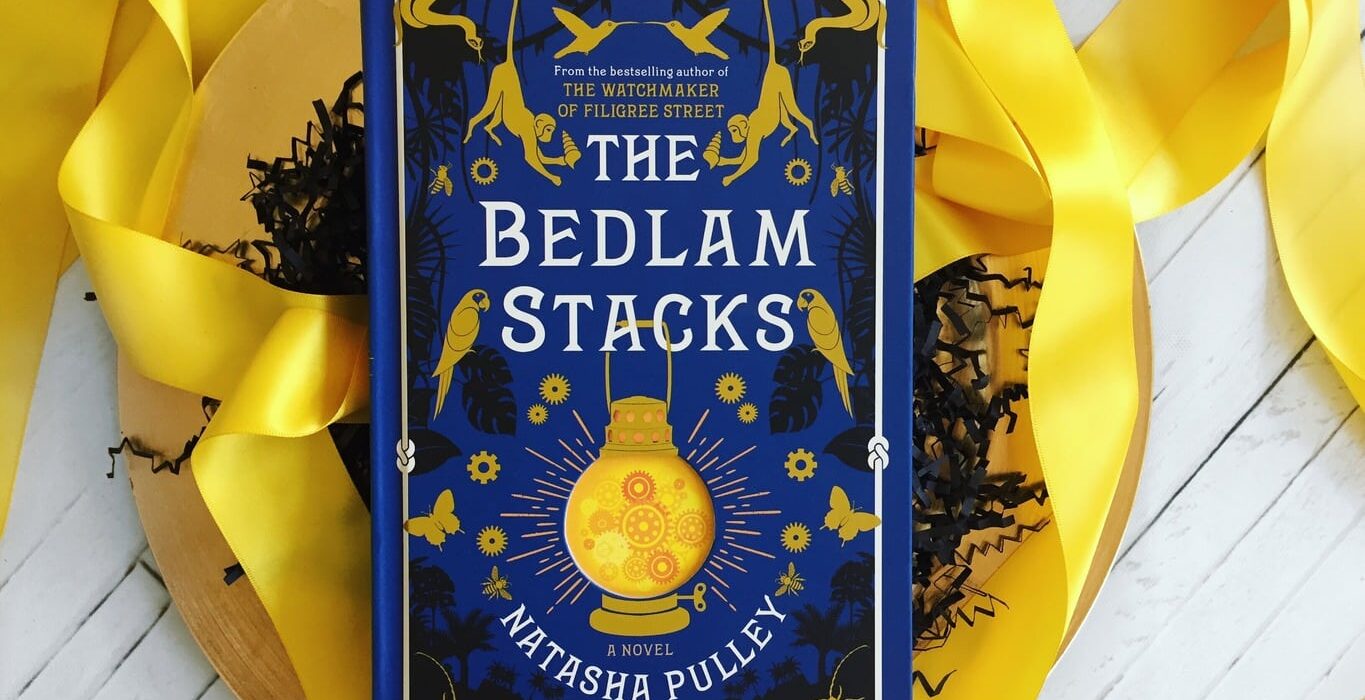Happy book birthday to The Bedlam Stacks by Natasha Pulley! I received this book as an advanced copy from Bloomsbury USA, and with it was a sort of companion novel (though you don’t have to read one in order to read the other), The Watchmaker of Filigree Street. If you didn’t read my review of that one, here’s the gist of it: I didn’t like it. I was worried I’d feel the same about The Bedlam Stacks, so my husband said he’d read and review it for me! So TA-DA, feast your eyes on my VERY SPECIAL GUEST review featuring Cole, the husband!
 The Bedlam Stacks by Natasha Pulley
The Bedlam Stacks by Natasha Pulley Published by Bloomsbury USA on August 1st 2017
Genres: Historical Fiction, Fantasy
Pages: 336
Format: Paperback
Source: Bloomsbury
Buy on Amazon, Buy on Barnes & Noble, Buy from The Book Depository
Goodreads
In 1859, ex-East India Company smuggler Merrick Tremayne is trapped at home in Cornwall after sustaining an injury that almost cost him his leg and something is wrong; a statue moves, his grandfather’s pines explode, and his brother accuses him of madness.
When the India Office recruits Merrick for an expedition to fetch quinine—essential for the treatment of malaria—from deep within Peru, he knows it’s a terrible idea. Nearly every able-bodied expeditionary who’s made the attempt has died, and he can barely walk. But Merrick is desperate to escape everything at home, so he sets off, against his better judgment, for a tiny mission colony on the edge of the Amazon where a salt line on the ground separates town from forest. Anyone who crosses is killed by something that watches from the trees, but somewhere beyond the salt are the quinine woods, and the way around is blocked.
Surrounded by local stories of lost time, cursed woods, and living rock, Merrick must separate truth from fairytale and find out what befell the last expeditions; why the villagers are forbidden to go into the forest; and what is happening to Raphael, the young priest who seems to have known Merrick’s grandfather, who visited Peru many decades before. The Bedlam Stacks is the story of a profound friendship that grows in a place that seems just this side of magical.
I received this book for free from Bloomsbury in exchange for an honest review. This does not affect my opinion of the book or the content of my review.
When Ali got an advanced copy of ‘The Bedlam Stacks,’ it seemed like a story that would be right up my alley: East India Company operatives in Peru, perhaps with elements of Magical Realism, and cover art featuring gears (Steampunk in Peru?)? An era I enjoy reading about, in an exotic locale, in a style and genre I love… homerun, right? This book started on track for a solid four stars, but unfortunately lost one along the way.
My major complaint:
My major complaint with this book is the magical realism elements. I love the idea of a book set in South America, the land of Marquez and Borges, riffing off their most famous literary export, but it turns out magical realism is a fine needle to thread and Pulley may have missed the mark.
In my mind magical realism isn’t just about the magic (that would be fantasy) and obviously isn’t just about the realism – it’s creating a world in which the fantastic seems commonplace and the commonplace can seem fantastic. Here the author went over the top with the magic, introducing luminescent pollen, exploding ducks, things that float in air that normally wouldn’t, glass roads… I could go on, and not even give any spoilers, because it seems there is a new fantastical element on every page. Pulley tries to explain these elements, which ultimately cheapens them (as a medical professional, I find myself saying ‘that wouldn’t make a duck explode,’ rather than, ‘that seems legit’).
I get that Peru is supposed to be a down-the-rabbit-hole experience for the main character, but he would likely be aware of the crazy stuff going on down there since it is set in colonial times, his family had previously been there, and things this bizarre and out of the ordinary would likely at least be curiosities to educated circles. In short, I wish there was less, or at least more subtle, magical elements, and more focus on the very interesting plot of East India Company men sneaking trees out of Peru to break a quinine monopoly.
But I really enjoyed!…
What I really liked about this book was Rafael, the Peruvian priest, and his mysterious history. I liked the references to ancient Incan culture and civilization, either historical or fabricated. As I mentioned above, I really, really like the main plot that seems to get muddied up in all the fantasy elements. Two men smuggling quinine out of Peru, with hints of a conspiracy covered up by the local superstitions. And, for all my whining about the magical stuff, some of it made for some evocative scenes and I was disappointed that I got burnt out on it. The inexplicable winter-in-summer atmosphere, the glowing pollen leaving trails through the forest, the mysteriously sentient stone statues would’ve been just enough (exploding ducks can apply elsewhere, thank you).

![]()
![]()
![]()
This book is for someone who enjoys South American settings, and those who enjoy a lot of magic in their magical realism.

A.S. Thornton has evolved from book blogger to author with a particular fondness for writing forbidden love in ancient deserts. When not writing, she’s caring for dogs and cats as a veterinarian. You’ll never find animals at the center of her writing, though, because those fictional worlds don’t have veterinarians and her literal brain can’t accept that the poor critters would be without parasite prevention. Thornton’s debut, DAUGHTER OF THE SALT KING is available wherever books are sold.





Maraia
What a good idea, Ali!
And great review, Cole! I agree about magical realism. If the author wants to write fantasy, she should do it. I definitely prefer magical realism to not overdo the magical elements.
Ali
Hahah, thanks! I figure if Cole is going to be reading some books that fit my blog, he should help out a bit (;
And he said he’s with you on the magical realism! It’s not an easy genre to tackle well.
Kristen @ Metaphors and Moonlight
This sounds like an interesting book, but it does sound like maybe the magic/fantasy part was laid on too thick. I’m kind of curious now, what *would* make a duck explode? Haha. I do think sometimes fantastical, paranormal, and sometimes even sci-fi elements in books are better left unexplained.
Kristen @ Metaphors and Moonlight just posted Book Review: The Storm Lords by Ravon Silvius
Ali
I always prefer those elements to be unexplained. I feel like the more an author does to try to explain something, the more holes I’ll find in the explanation!
Norse Mythology: "My Favorite Thing I've Read In A Long Time" Guest Review - the bandar blog
[…] and gentlemen, I have enlisted my husband (again!) to write a review for the blog. He read Norse Mythology long before I did, and he loved it so […]